Trout Fishing
Introduction to Trout Fishing
The term "trout" is actually a term that is used to describe a number of species that belong to the Salmonidae family. Common members of this family are the salmon, char, grayling and whitefish. Fishresource.com focuses on the most popular and widely known species of fish referred to as trout; the brook trout, brown trout, cutthroat trout, lake trout and the rainbow trout. Visit each individual trout species page to learn more about each species.
Individual Species Overview
Brook Trout
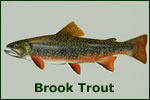 The brook trout, (Salvelinus fontinalis), a member of the char group is not actually a trout. Native to northeastern North America, the brook trout is one of the most popular game fish of the char group. Like the lake trout, the brook trout is found throughout the northern part of the continent, but also found in the waters from the United States to South America and Europe. The brook trout, (Salvelinus fontinalis), a member of the char group is not actually a trout. Native to northeastern North America, the brook trout is one of the most popular game fish of the char group. Like the lake trout, the brook trout is found throughout the northern part of the continent, but also found in the waters from the United States to South America and Europe.
Brown Trout
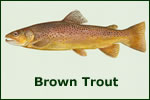 Originally from Europe and North Africa, the brown trout (Salmo trutta) was introduced to North America in 1882. Excellent sport fish and table fare, like other members of the trout species, brown trout (called speckled carp by early anglers) are cannibals. Still, despite this tendency, the brown trout are one of the trout species most likely to strike an artificial fly. Originally from Europe and North Africa, the brown trout (Salmo trutta) was introduced to North America in 1882. Excellent sport fish and table fare, like other members of the trout species, brown trout (called speckled carp by early anglers) are cannibals. Still, despite this tendency, the brown trout are one of the trout species most likely to strike an artificial fly.
Cutthroat Trout
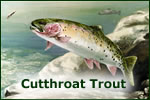 Native to the western United States and Canada, the cutthroat trout (salmo clarki) obtains its name from a streak of red colour beneath its lower jaw. Cutthroats often hybridize with other trout, especially the rainbow. In many areas, the two varieties exist as an indistinct strain. Like the brook trout, the cutthroat is vulnerable to over-fishing and to disruptions in the local environment. Native to the western United States and Canada, the cutthroat trout (salmo clarki) obtains its name from a streak of red colour beneath its lower jaw. Cutthroats often hybridize with other trout, especially the rainbow. In many areas, the two varieties exist as an indistinct strain. Like the brook trout, the cutthroat is vulnerable to over-fishing and to disruptions in the local environment.
Lake Trout
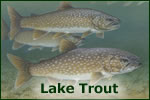 Belonging to the char group, the lake trout (Salvelinus namaycush) is known as togue (in the Northeast), mackinaw (in the West), and as gray trout in much of Canada. Native throughout Canada and across the northern United States, lake trout require cold, well-oxygenated waters from 43°F to 56°F. Visit the Lake Trout page to learn tips and techniques. Belonging to the char group, the lake trout (Salvelinus namaycush) is known as togue (in the Northeast), mackinaw (in the West), and as gray trout in much of Canada. Native throughout Canada and across the northern United States, lake trout require cold, well-oxygenated waters from 43°F to 56°F. Visit the Lake Trout page to learn tips and techniques.
Rainbow Trout
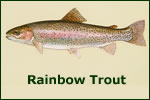 The natural range of the rainbow trout (Salmo gairdneri) is from northern Mexico to the Aleutian Islands. The two distinct strains of rainbow trout are the steelhead and shasta strains. The former has a migratory instinct to swim to the sea, while the shasta strain is non migratory. Inland stocking programs have allowed both strains to mix, creating inland rainbows with the dominant migratory instinct. The natural range of the rainbow trout (Salmo gairdneri) is from northern Mexico to the Aleutian Islands. The two distinct strains of rainbow trout are the steelhead and shasta strains. The former has a migratory instinct to swim to the sea, while the shasta strain is non migratory. Inland stocking programs have allowed both strains to mix, creating inland rainbows with the dominant migratory instinct.
Stream Trout Fishing
Fishing for stream trout can be some of the most rewarding and enjoyable fishing you will ever experience. Not only are they beautiful fish, but most often when stream fishing, you find yourself in a beautiful environment. Stream trout are actually coldwater fish, requiring cold, well-oxygenated waters throughout the seasons, whether they are in streams or lakes. they make their nests or "redds" in stream gravel in the cooler, faster moving, oxygen rich waters. This is one reason that stream trout rarely naturally reproduce in lakes and are continuously stocked.
In North America, anglers generally pursue four stream trout species: the brook trout, brown trout, rainbow trout and the cutthroat trout, all of which are featured on individual pages. The brook trout are considered the easiest to catch and the brown trout tend to give the biggest challenge.
Again, favouring cooler waters, stream trout are rarely found in waters above 65°F in temperature, and as such can be found mostly in the upper reaches of streams and at tributaries. Rainbow and cutthroat trout, however, are sometimes found in temperatures as high as 70°F. Streasm trout have insects as their primary diet and also depend on smaller fish to survive in lakes. Knowing the local diet of the trout you are after will assit you in choosing your bait and how to present it.
It is widely known that trout tend to spook easily - they are known for their alertness and awareness of their surroundings. It is best to do the least to advertise your presence. The trout has a number of natural enemies including the angler, so it should be of no surprise that these fish are always on their guard.
When hooked and when spooked or alarmed, these fish tend to burst for cover. Cover for the stream trout can range from the shade of an overhanging tree branch to behind underwater rocks. If you manage to hook one, especially the larger, more powerful swimmers, you should be prepared for this burst as these fish are known for snagging lines and breaking free.
|